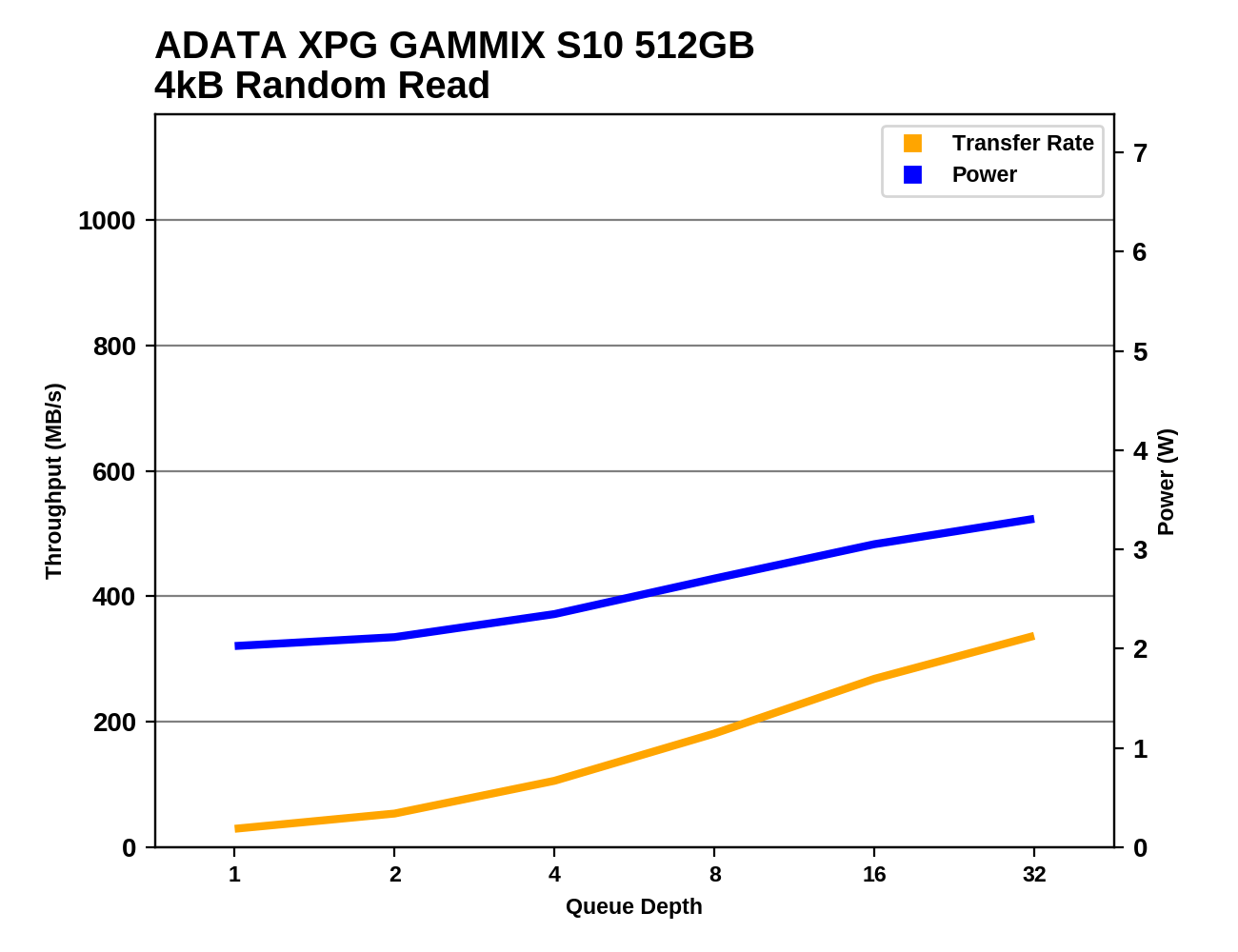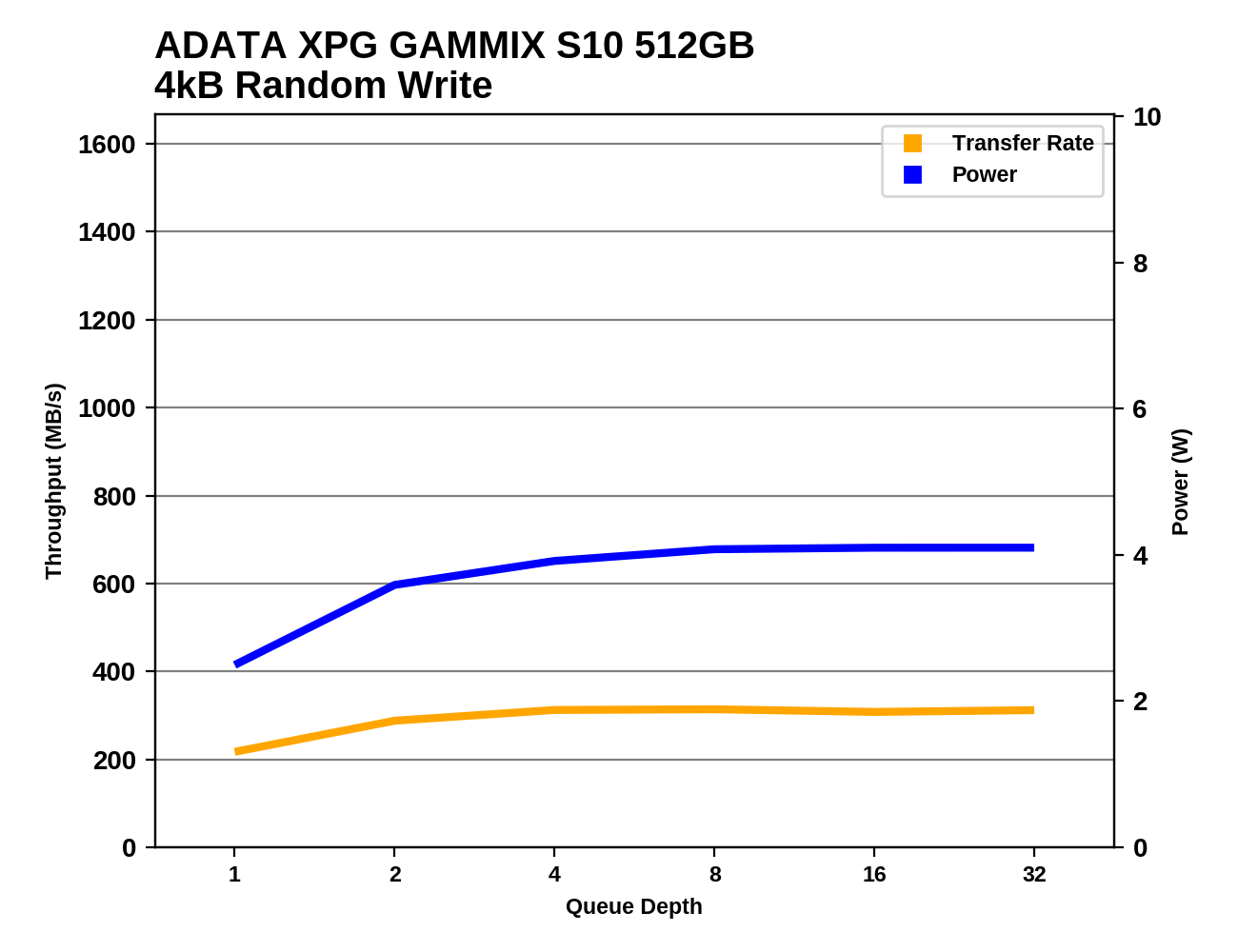The ADATA XPG GAMMIX S10 (512GB) SSD Review: Entry-Level NVMe With Style
by Billy Tallis on October 25, 2017 8:30 AM ESTRandom Read Performance
Our first test of random read performance uses very short bursts of operations issued one at a time with no queuing. The drives are given enough idle time between bursts to yield an overall duty cycle of 20%, so thermal throttling is impossible. Each burst consists of a total of 32MB of 4kB random reads, from a 16GB span of the disk. The total data read is 1GB.

The burst QD1 random read speed of the ADATA XPG GAMMIX S10 is much better than that of the Intel 600p, but still slower than Samsung's SATA SSDs and any other NVMe SSD. The GAMMIX S10 has the highest burst random read speed of any SSD we've tested with Intel/Micron 3D NAND, including the Intel 545s with the second-generation 64L 3D NAND.
Our sustained random read performance is similar to the random read test from our 2015 test suite: queue depths from 1 to 32 are tested, and the average performance and power efficiency across QD1, QD2 and QD4 are reported as the primary scores. Each queue depth is tested for one minute or 32GB of data transferred, whichever is shorter. After each queue depth is tested, the drive is given up to one minute to cool off so that the higher queue depths are unlikely to be affected by accumulated heat build-up. The individual read operations are again 4kB, and cover a 64GB span of the drive.

When higher queue depths and longer run times come into play, the random read speed of the GAMMIX S10 doesn't look so good. It is merely tied with the Crucial BX300 and behind the Intel 545s instead of being the fastest Intel/Micron 3D NAND SSD, and everybody else's flash offers faster random read speeds.

The GAMMIX S10 has poor power efficiency to go along with its poor random read speeds. The best NVMe SSDs using TLC NAND are close to twice as efficient for random reads as the GAMMIX S10.
 |
|||||||||
The Intel 600p and Crucial MX300 are the only SSDs in this bunch that are slower than the GAMMIX S10 at every queue depth. Any other NVMe SSD scales to much higher random read performance as queue depth increases.
Random Write Performance
Our test of random write burst performance is structured similarly to the random read burst test, but each burst is only 4MB and the total test length is 128MB. The 4kB random write operations are distributed over a 16GB span of the drive, and the operations are issued one at a time with no queuing.

The burst random write speed of the ADATA XPG GAMMIX S10 is pretty good for a TLC-based NVMe SSD. MLC-based NVMe SSDs with more powerful controllers can do even better, but the GAMMIX S10's performance is nothing to complain about.
As with the sustained random read test, our sustained 4kB random write test runs for up to one minute or 32GB per queue depth, covering a 64GB span of the drive and giving the drive up to 1 minute of idle time between queue depths to allow for write caches to be flushed and for the drive to cool down.

On the longer test of random write performance, the GAMMIX S10 is slightly faster than the Intel 600p and WD Black, which themselves hold a small advantage over SATA SSDs. Most other NVMe SSDs are quite a bit faster than the GAMMIX S10.

The power efficiency of the GAMMIX S10 during the random write test is not quite as bad as the Intel 600p or WD Black, but it is still poor with performance on par with early NVMe drives like the Samsung 950 PRO and notoriously power-hungry Intel 750.
 |
|||||||||
The random write speed of the ADATA XPG GAMMIX S10 has mostly saturated by QD2, and the top speed it reaches on this sustained performance test is lower than many mainstream SATA SSDs. Most NVMe SSDs of this capacity or larger are able to continue increasing performance as queue depths grow, leading to performance that surpasses the limits of SATA.










27 Comments
View All Comments
Flunk - Wednesday, October 25, 2017 - link
Even a proper heatspreader doesn't cool the underlying components, to do that you need fins to dissipate heat. Add fins to a heatspreader then you have a heatsink. I'm not saying heatspeaders are worthless, but they don't do much unless attached to something else.ddriver - Wednesday, October 25, 2017 - link
The heatspreader will work, if it has good contact with the chip, which it doesn't.The purpose of the heat spreader is ... well... to spread heat. This gives you more surface to displace heat. Fins serve to increase the head-spreading effect further, although for this product in particular I doubt fins are necessary. In fact, as I mentioned above, the way the heatspreader is implemented and the pathetic performance itself suggest that the cooling solution is 100% unneeded, and present purely for cosmetic purposes.
znd125 - Wednesday, October 25, 2017 - link
Information on the die/channel configuration is lacking in many SSD reviews by Billy Tallis. This information is especially important for SSDs using non-power-of-2 density NAND chips, which often result in awkward die/channel configurations that consequently lead to low performance. Tallis rarely discusses this.It is not enough to simply state "... severely reduced performance potential due to not being able to populate every channel of the controller with NAND flash chips". I expect more from AT articles. If not every, how many channels are populated? How many dies are in each channel? Are they evenly distributed? Tell us exactly how the channels are populated and then you can go on to judge whether that is good or bad.
As another example, Tom's Hardware in their Intel 600p review pointed out the drive was able to use only 6 of the 8 channels. Tallis did not. To me, that is not a trivial piece of information. That is THE reason the 600p does not reach its "performance potential" IMO.
Ratman6161 - Wednesday, October 25, 2017 - link
While I too would be interested to see the information you are seeking, I don't think its a critical flaw in the article. For those interested in making a buying decision, its the performance scores and the price and the price/performance equation that matter. Other information is useful if you want to know why one performs better than another. However, with nearly all SSD reviews these days, I usually end up just skimming through to the conclusion. If its a SATA drive, all I really want to know is where is its price/performance ration vs a Samsung 850 EVO. If its NVMe then the price/performance comparison is against the 960 EVO.However....here is something I really would like to see more of. When drives are tested I would like to see the same drive tested in different sizes...which is kind of getting into what you are talking about indirectly. For example, in all the charts you can see a pretty substantial difference between the 1TB and 250 GB 960 EVO's. It really would be nice to see a 512 GB in there. A drive that wins at 1 TB may not win at 512 GB. Unfortunately when I was buying the 512 is what was in my price range and I had to do some digging for information on that. THG actually did review all three sizes.
DanNeely - Wednesday, October 25, 2017 - link
Assuming the conclusion is right about next year's controllers being massively better than the current generation they can't get here soon enough. None of the controllers currently available to the down market OEMs are remotely competitive with samsung's last few generations of parts.MrSpadge - Sunday, October 29, 2017 - link
Adatas strategy seems to be: make many bad SSDs with fancy names and hope someones buys them by accident. Otherwise I can't explain this and the preceeding drives.